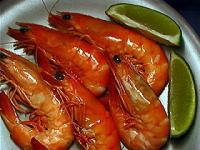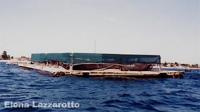Aquaculture – an alternative?
Aquaculture is the cultivation of marine or freshwater animals and plants, in a confined and more or less controlled environment. The final products are mostly used for commercial purposes. Fish, molluscs, crustaceans and seaweed are being cultivated and grown in cages, nets or ponds in coastal waters, estuaries, mangroves, dams and other waterways.
For centuries people trapped young fish and crustaceans by blocking off mangrove swamps and estuaries to create temporary ponds in which their catch could be kept until large enough to be eaten. Eventually more permanent ponds were built and stocked with fish or crustaceans collected in the wild.
For seaweed small cuttings are collected and attached to nylon lines suspended in grids. The final products are processed for food, drinks and numerous other applications like shoe-polish and added to medium used for growing bacteria in hospitals and medical research.
Scientific research has developed advanced breeding techniques for fish, crustaceans and molluscs and capture of wild stock is not always needed. A number of species are now hatched and bred in captivity and at a later stage transferred to outdoor or indoor ponds.
There are species that will not spawn in captivity. These are caught in the wild and kept in so called fattening cages, which float in the open ocean. Here they are kept and fed until large enough to be harvested and sold.
All over the world aquaculture is an expanding industry. In 1998/1999 aquaculture in Australia was worth approximately $600 million ? comprising 30% of the total value of fisheries production.
Aquaculture seems a good alternative for the more destructive way commercial fishing takes place these days. Trawler nets do great damage to reefs by scraping over the delicate substrate, wiping out entire habitats. Just like trawling, longline-fishing (see elsewhere on this web site) is not discriminate enough and many, also endangered species, are killed every day. Not to mention ghost nets: nets that went adrift and are unretrievable, but keep on catching fish, mammals and seabirds. Highly sophisticated technology is used to find, capture and kill marine life giving our oceans no chance of recovering the disturbed balance.
But is aquaculture the answer?
Because the animals and plants are kept at much higher densities than in the wild, diseases and parasites are more prevalent. Pathogens that would normally exist at relatively low levels in wild life populations are problematic in densely packed aquafarms. As sick or dead stock are a loss to the farmer many precautionary measures of disease introduction and spread are taken.
The excessive use of antibiotics in earlier days already has resulted in bacterial strains that are highly resistant to a wide range of different antibiotics. Many of those bacteria are not only a threat to the aquaculture industry, but can also be transferred to humans (e.g. Vibrio spp, Listeria monocytogenes, which both can cause severe food poisoning).. Uneaten food pellets containing antibiotics end up under fattening cages or on the bottom of outgrow ponds where they can do further damage. The antibiotics contained in the foodpellets are released into the water and soil, and diluted to minute concentrations. Bacteria that come in contact with such low concentrations can easily overcome the effects it might have and develop resistance to those antibiotics.
Despite the use of antibiotics and pesticides, diseases such as infectious salmon anaemia (ISA) still occur. Some scientist claim that the disease is caused by the conditions in which farmed fish are kept and is not of great concern to fish in the wild. However in October 1999 scientists in New Brunswick (North America) discovered ISA in wild salmon. And in early November 1999 Scottish officials confirmed that ISA has been found in wild Scottish salmon.
Sea lice are much more prevalent in areas nearby salmon farms, then anywhere else. DNA studies have proven those sea lice originated from those that have infected cultivated species nearby.
Numerous studies have been performed on the effect of waste generated by aquaculture. Various groups have documented an increase in nitrogen and phosphates in the direct vicinity of aquafarms. A well-known consequence of water that is too high in nutrients is the explosive growth of phytoplankton, better known as algal blooms. Algal blooms do not only deplete water from oxygen, certain species can clog the gills of fish and invertebrates. Further, toxins produced by some phytoplankton species can accumulate in shellfish, such as mussels, scallops and oysters and cause amnesic, paralytic or neurotoxic shellfish poisoning in humans, which can result in permanent brain damage or even death. Cases involving shellfish poisoning are well documented and have been associated with salmon and scallop farms in Scotland and Canada.
However, other research groups have come to different conclusions. Some say it doesn’t have an impact. Others say the impact restricts itself to a radius of ten meters around the cages. In a lot of places annual benthic monitoring (video/photo of substrate underneath cages, oxygen demand, pH etc.) is required depending on speed of currents and size (weight in tonnes) of the farms.
Especially when the escaped species is not native to the area and adapts to the new environment, catastrophe is imminent. When the seaweed Euchema escaped from a Hawaiian farm it developed into heavy infestations, leading to the reduction in native fish and invertebrate populations. On the West coast of Northern America Atlantic salmon are now establishing themselves, competing with the native Pacific salmon for food, habitat and breeding grounds.
Although the Atlantic salmon is native to Scotland, escapees also cause major problems in that region. The cultivated stock is bigger and stronger and outcompetes the wild stock of Atlantic salmon. One of the other consequences is that accidental successful breeding of the farmed fish could bring the level of adaptation of the species down, since farmed fish are generally less adapted to life and survival in the wild.
As mentioned before, diseases are more prevalent in cultivated stock. The cultivated species might carry diseases that are under control in the aquaculture environment, but explode and cause epidemics once the pathogens are released into the surrounding environment.
For obvious reasons predation from wildlife is a problem for aquaculture farmers. Birds and other wildlife that pose a threat are killed or removed to prevent loss of stock. Marine life like whales, sea lions and birds are killed, wounded and harassed by net entanglements and farmers using guns and acoustic deterrent devices to protect “their” fish.
Another problem is that most of the species being cultivated are carnivores and need a diet of fish oil and protein. It can take up to 90 tons of wild marine fish, such as sardines and anchovies, ground up into fish meal feed to produce 30 tons of mature shrimps or salmon. Some research groups are working on the development of using other sources of dietary supplements, such as meat products. A large risk of feeding fish meat product could be the cross over of pathogens.
For the farming of shrimp and milkfish, mangroves and estuaries proved to provide the right conditions. Trees are removed and ponds dug out. Unfortunately after 2 to 10 years these sites are no longer usable, leaving the once fertile coastal ecosystem bare and exposed to erosion which has direct consequences for coral reefs and other habitats nearby. As we all know mangroves and estuaries play major roles in the lifecycle of a tremendous number of different aquatic species. This is especially happening in developing countries which need the income aquaculture provides. Developed countries such as the USA and Europebenefit from these practices, since they can get around the strict environment regulations required in their own countries and save a lot of money importing prawns from those countries.
Aquaculture will expand due to a decrease in wild stock and the demand for seafood increases as people are looking for alternatives to chicken, pork and beef. It is important to make it a viable and ecological sustainable alternative. Research into aquaculture could help the oceans by increasing numbers of threatened and endangered species and give us an insight into the lifecycle of many species. In Australia a large number of fingerlings hatched in captivity are released to stock dams, waterways and estuaries. Further more Australian farmed prawns are all cultivated in indoor ponds and strict EPA regulations for monitoring of wastewater do apply. Regular workshops on how to handle stock and prevent disease and stress in animals are held, so staff is well informed, which only benefits aquaculture as an industry.
With proper effluent treatment and a better control on the use of antibiotics and toxic pesticides the final product will be safer and less destructive to our oceans and waterways. At this moment in time not enough research has been conducted to keep diseases and stress factors from the animals and plants we are trying to cultivate on a large scale.
References
- http://www.affa.gov.au/fisheries/aquaculture
- http://www.greenpeace.org
- The Greenpeace Book of Coral Reefs, 105 ? 108. Sue Wells and Nick Hanna ISBN 0-8069-8795-2
- http://www.asf.ca
- North Coast Sustainable Aquaculture Strategy, August 2000
- http://www.aqua-environment.com
- Aquaculture Prospects for Marine Fish in NSW, NSW Fisheries







